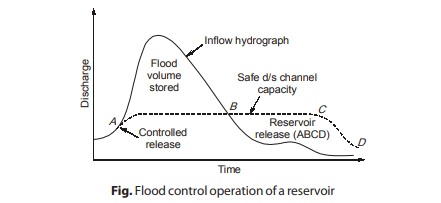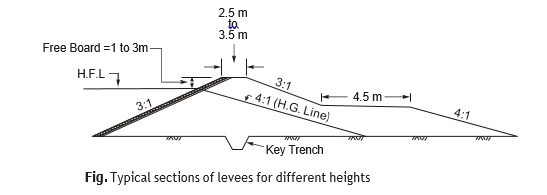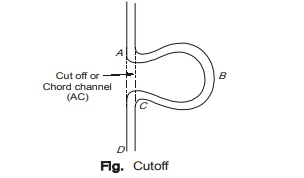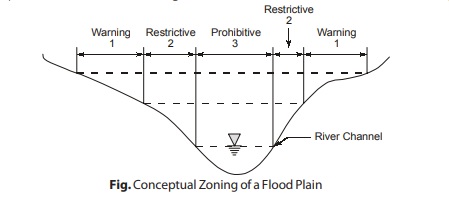Flood Control
The term flood control is commonly used to denote all the measures adopted to reduce damages to life and property by floods. The complete control of flood is neither physically possible nor economically feasible. The flood control measure can be classified as structural and non-structural methods:
Structural Method
Various structural methods for flood control are as follows:
a. Storage and Detention Reservoir: These are most reliable and effective method of flood control. In this method, a part (or whole) of the storage in the reservoir is kept apart to absorb the incoming flood and the stored water is released in a control way over an extended time so that downstream channels do not get flooded.

- Detention reservoir are essentially small structure and operate to reduce the peak flow by providing temporary storage and restriction of outflow rate. A detention reservoir consists of an obstruction to a river with an uncontrolled outlet.
b. Levees: Levees also known as dikes or flood embankment or flood wall are that constructed parallel to the course of the river to confine it to a fixed course and limited cross-sectional width. The height of levees will be higher than level of design flood with sufficient free board.
- Such embankments may be raised higher on both sides of river or only on one side, for some suitable river length, where the river passes through place of importance.

- Dike or levee represents the earthern wall while the flood wall is generally used to represent the R.C.C. wall or masonry wall.

- The cross section of the levee should have to be desired like on earthen dam for complete safety against all kinds of saturation and drawdown possibilities.
The advantages of dikes are as:
- It is probably the cheapest of structural flood-control masonry although at higher level it may become quite expensive.
- The materials required for their construction are usually locally available.
- It is the only single method for preventing inundation on tidal areas, where the land is below the maximum tidal level.
The disadvantages of dikes are as:
- The levees are fragile works and their breaching may cause tremendous loss of life and property.
- The maintenance and supervision cost are high.
- They are open to direct attack by river flow, which may code and undermine the levees, and may result in their failure.
- Levees make the drainage of low lying area more difficult, and special works are to be constructed.
- On levees river, silt is not deposited in the flood plains, and thus the silt charge which the river carries upto it joins to the sea is more than leaves river.
c. Flood Ways: Flood ways are the channels into which a part of the flood will be diverted during high stages. A flood way can be a natural or man-made channel and its location is controlled essentially by the topography.
It is advisable that the diversion of flow be controlled by providing a regulator, so to avoid deterioration of the river in future.
d. Channel Improvement: Channel improvement means increasing the water carrying capacity of channel. Following works come under this category:
- Increase the cross-sectional area of channel by widening or deepening it.
- Clearing of channel reduces the channel roughness, by which the velocity of flow increases.
- By cutoff channel, short circuiting of meander loops occurs, which leads to increased slope and thus velocity increases.

These methods are essentially short-term measure and requires continued maintenance.
e. Watershed Management: Land treatment and watershed management in the basin aims to cutting down and delaying the runoff before it gets into the river. Watershed management measure includes developing the vegetative and soil cover in conjunction with land.
Treatment works like check dams, contour bonding, terraces, etc. These treatment cause increase in infiltration, increase in evapotranspiration and reduction in soil erosion. These all treatments lead to moderation of peak flows and increasing of dry weather flows.
Non-structural Method
Various non-structural methods for flood control are:
a. Flood Plain Zoning: When the channel discharges are very high, it is to be expected that the channel will overflow its banks and spill into the flood plains. Flood plain management identifies the flood prone areas of a river and regulates the land use so that it restricts the damage due to flood.

The location and extent of areas likely to be affected by floods of different return period are identified and these area are developed in such a manner that the resulting damage due to floods are within acceptable limit of risk.
|
Zone |
Flood Return Period | Example of Uses |
|
1 |
100 Years | Residential houses, offices, Factories, etc. |
| 2 | 25 Years |
Parks |
| 3 | Frequent |
No construction/ Encroachments |
b. Flood Forecasting and Warning: Forecasting of floods should be done in advance, so that it enables us to give warning to the affected people and take appropriate precautionary measures.
These technique can be divided on the basis of time of forecasting:
- Short-Range Forecast: This method gives advance warning 12-40 hours for flood.
- Medium-Range Forecast: This method gives advance warning of 2-5 days for floods, by using rainfall-runoff relationship.
- Long-Range Forecast: Using orders and meteorological satellite data, time of occurrence of event are predicted well in advance.
c. Evacuation and Relocation: Evacuation of communities along with the valuables in the chronic flood affected areas and relocation of them in safer location, when high floods ore severe cyclones are expected.
d. Flood Insurance: Flood insurance provides a mechanism to modify the impact of loss burden.

